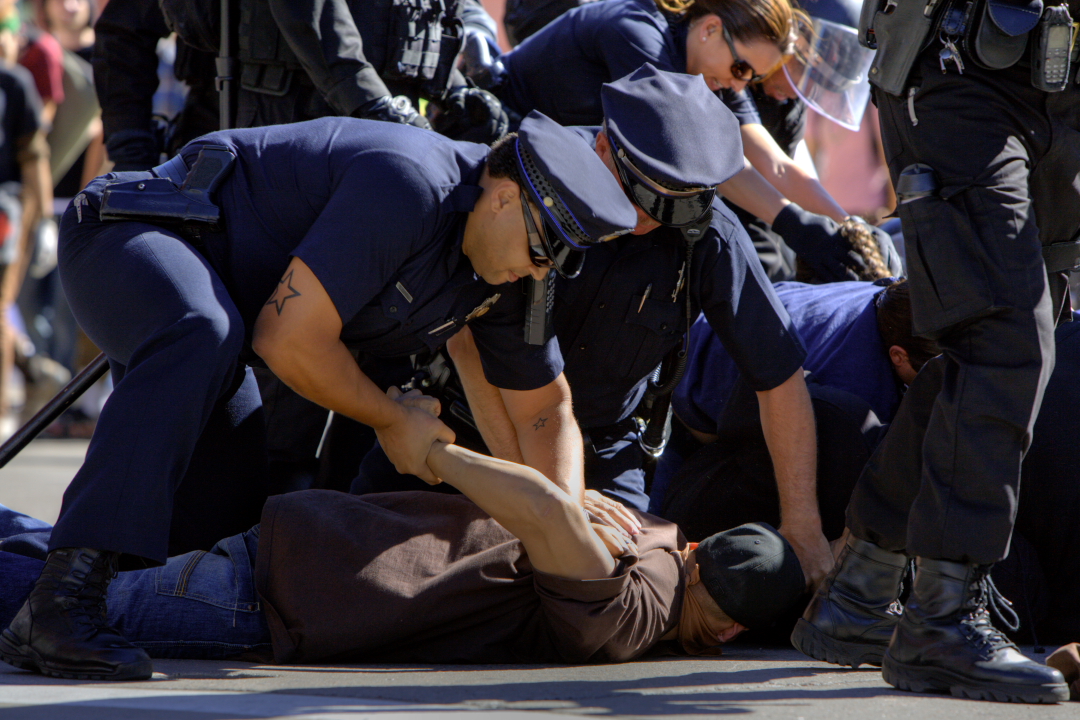Originally published at MintPress News.
DENVER — The death of a Rosebud Sioux man in Denver earlier this month is a painful reminder that police shootings are not limited to any one part of the United States, and certainly not just to places that received mainstream media attention after recent killings.
On July 12, Lynn Eagle Feather called police for help with her schizophrenic son, Paul Castaway. Witnesses and police give conflicting accounts of an incident that quickly spiraled out of control. Officers shot Castaway multiple times while he held a knife to his own neck. He died the following day at an area hospital. Police say they shot in self-defense, but witnesses and Castaway’s family disagree.
As his family struggles for justice, a diverse coalition of protesters from the American Indian Movement to local groups like Denver Community Defense Committee are working with the families of the victims of Denver police brutality. They’re hoping to draw attention to a largely overlooked epidemic of police violence that rivals other cities like Baltimore or New York City for its ability to destroy lives. Now, police are targeting activists and journalists who support them with arrests and even violence.
‘What’s wrong with you guys?’: The death of Paul Castaway
In a conversation with MintPress News last week, Lynn Eagle Feather told MintPress that she wanted police to force her son to calm down and rethink his actions. She says she never intended to risk his life.
“Usually I can control him, and talk him down,” Eagle Feather said by phone last week. That night was different, though. Paul Castaway seemed especially haunted. Eagle Feather snuck out of her house and called 911, because, she said, “I thought if I filed charges, he’d understand that he can’t act like this.”
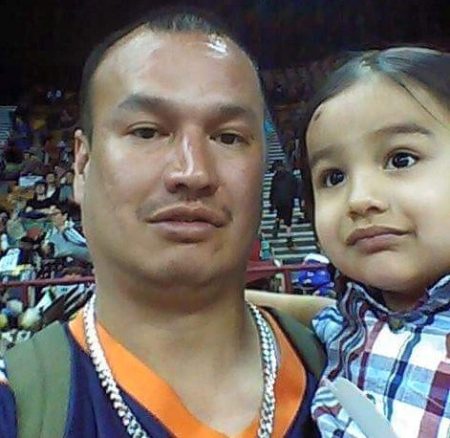
Not only did she inform the officers and 911 of his mental illness, but Eagle Feather also added that police in her district had encountered him before and should have been familiar with his condition. She also denied police claims that Castaway stabbed her. She said officers saw her neck that night, which didn’t require medical care and shows no sign of injury today.
Castaway fled from police into a neighboring trailer park and became trapped. Eagle Feather witnessed the moments that led to her son’s death on a security camera video, shown to her by the manager of the Capital City Mobile Home Park. She says the owner of the trailer park told its manager to stop cooperating with Eagle Feather and the media soon after her viewing, and the video has not been released to the public.
“He came out and put the knife to his own neck. And he stood there,” Eagle Feather recounted. “He stood there and he kind of stumbled toward the police and they shot him four times at close range. The cops were right in front of him, at the most six feet away.”
Tammy Vigil, a Fox 31 reporter, who was also allowed to view the surveillance tape, corroborated Eagle Feather’s account that Castaway was not threatening police when shot:
[The video] shows Paul Castaway, 35, coming up from behind a white mobile home, through a black iron fence onto the street and around a wooden fence, which is a dead end. He then turned back around onto the street with a knife to his neck the whole time, when an officer shoots him. The video seems to not match what police say happened.
“They could have tazed him, they could have maced him,” insisted Eagle Feather. Moments later, Castaway spoke what Eagle Feather said were his last words. “The police rolled him over and handcuffed him, after they shot him. He said, ‘What’s wrong with you guys?’ Those were his dying words.”
Whats Wrong With You Guys? Anonymous Takes Down Denver Police Union Website for #PaulCastaway http://t.co/JzBTBk411s pic.twitter.com/gqJ55YTMcU
— Anonymous (@YourAnonNews) July 17, 2015
The phrase “What’s Wrong With You Guys?” has since become a local rallying cry, appearing on banners, signs and even t-shirts.
Police violence targets Native Americans and the mentally ill
When MintPress spoke with Eagle Feather, she was making arrangements to bury her son — our interview was interrupted at one point by a call from the funeral home. She said she tries to focus on memories of the loving man she knew in day-to-day life, who was father to a young son. She recalled him as an avid fan of the Denver Broncos, who “never missed a game” and was looking forward to the upcoming start of football season. She praised his intelligence and his pride in his Native American heritage.
She remembered Castaway’s generosity. She recently gave him two jackets for Denver’s rainy weather, only for him to give them away to the homeless.
“Even though he battled his demons, he had a very big heart,” she said, later adding: “When he was little he used to bring home stray animals, and when grew up he’d bring me home stray people, people on the street, and he’d say, ‘Mom can you make them something to eat?’”
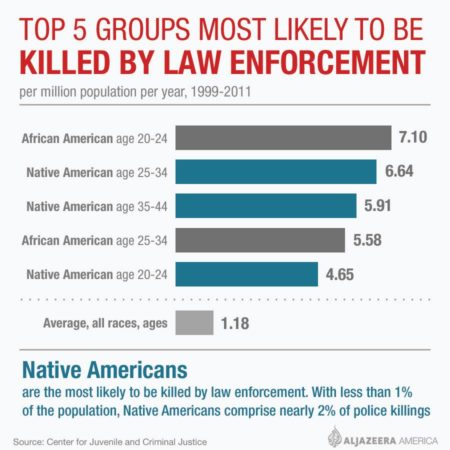
For Eagle Feather and others MintPress spoke with, Castaway offers a painful example of the ways police brutality often targets the mentally ill.
“I want justice and better training for police,” Eagle Feather said. Along with the frequent shootings of unarmed minorities, several cases of police killing mentally ill individuals with knives have come to light recently —police in Austin, Texas, shot a man to death during a mental health welfare check just one week before Castaway’s killing. Additionally, multiple activists we spoke with highlighted how Castaway’s case recalls the 2003 shooting of Paul Childs, a 15-year-old with developmental and learning disabilities, as well as epilepsy, who police said was armed with a knife. According to a timeline of events compiled by Inclusion Daily Express, a disability rights website, not only was the officer not charged with a crime but he even received a promotion two years later.
Race also plays a factor in cases like this one, Eagle Feather said. Statistics seem to agree: “With less than 1% of the population, Native Americans comprise nearly 2% of police killings,” according to an Al-Jazeera America report based on data from the Center for Juvenile and Criminal Justice. These and similar ones from the Centers for Disease Control’s National Center for Health Statistics suggest that young Native Americans are killed at a higher rate than almost any other demographic in the U.S. except African Americans aged 20-24, and at a far higher rate than the national average.
Denver activists report targeted arrests and police violence
Lynn Eagle Feather praised the support she’s received from community organizers, but also described police surveillance, saying visitors to her home told her they were later followed by police. It’s part of what local activists say is a pattern of repression that’s left them bruised, frequently arrested, and even facing criminal charges for exercising their constitutionally-protected right to assembly and free speech.
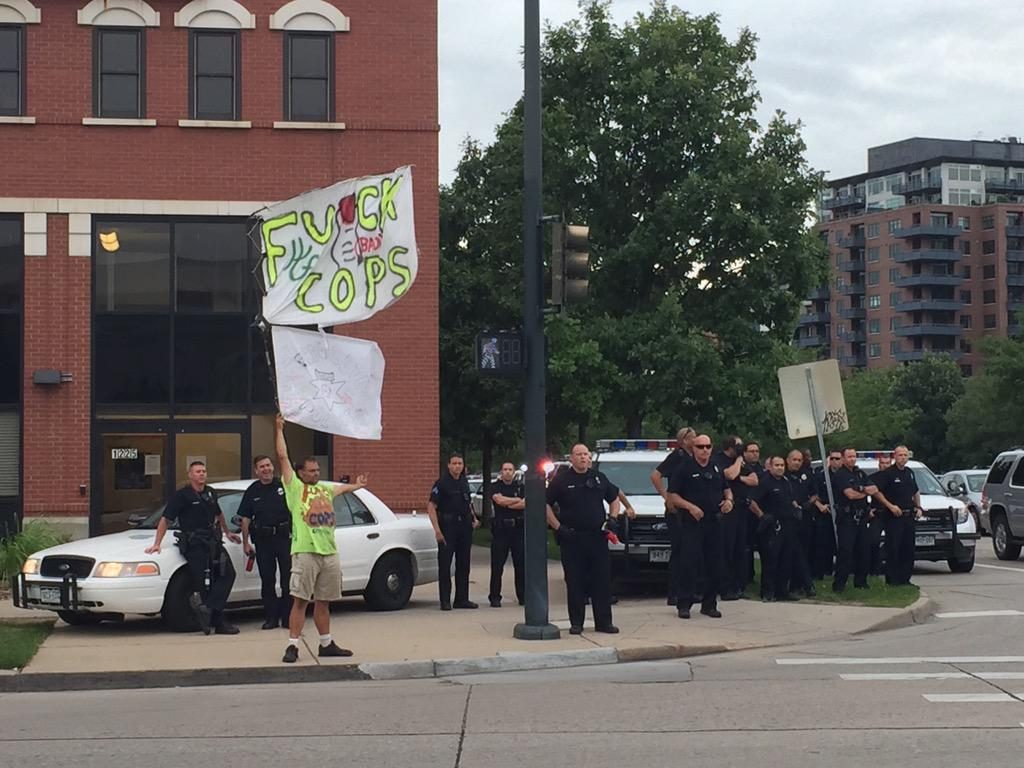
MintPress spoke with Josie Shapiro, a community organizer from Denver Community Defense Committee(DCDC), an anarchist group that supports families of police victims from fundraising for funerals and other expenses to organizing vigils or rallies, based on the wishes of the survivors. Many activists she knows have protested police brutality since at least the 2010 death of Marvin Booker, a homeless man killed in Denver police custody, but were further galvanized toward direct action by recent cases including the police shooting of Ryan Ronquillo outside a funeral home on July 2, 2014, and the police shooting of unarmed LGBT teenager Jessica Hernandez in January.
“The police force here has a long history of using violence and terroristic methods to move in on marginalized communities with constant street-level harassment,” Shapiro explained. She also cited rapid growth in Denver as another factor endangering the city’s minorities. “The murder of Paul Castaway and other instances of police brutality really back up the idea that the City of Denver is using the police force here as the enforcers of gentrification.”
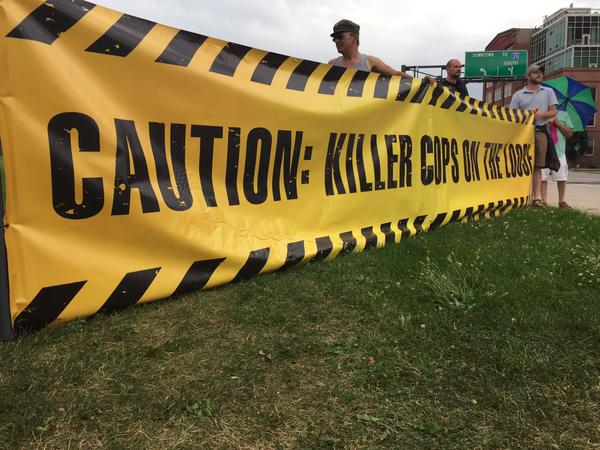
Tensions have also risen sharply between police and the groups targeting their abuse of power, especially since Valentine’s Day, when two activists allegedly poured red paint on a police memorial during a march for Jessica Hernandez. Jesse Benn, an activist and citizen journalist, gave MintPress his impression of what he’s observed in Denver in an email:
I see a community of truly dedicated, loving, and fierce activists, who are fighting at the intersections of oppression for racial, gender, economic, social and other justice … I also see activists routinely targeted, terrorized, and otherwise harassed by the Denver Police Department (DPD)—at protests and in their personal lives.
Journalists are no exception. “I realized very quickly that having a camera and a voice on social media made me a target for arrest,” Benn wrote. At a protest on April 29, police attacked Benn and his partner, Jessica. Benn and several others were arrested, and he was left with “a concussion, a macerated lip, a loosened tooth.” Cops “illegally detained [Jessica] with a baton to her throat.”
Shapiro said police aggressively targeted a July 14 march for Paul Castaway, organized by his family days after his death. “Immediately upon Paul’s family members entering into the streets from the plaza in front of the police station, there were police motorcycles ramming them and trying to force them back onto the sidewalk,” she said. Later, police ordered Shapiro off the sidewalk and, when she questioned the order, arrested her on the spot. She was charged with “disobedience of a police officer.”
Last week, activists targeted a regional police conference held in Denver with a series of protests. An action to shut down a “Law Enforcement Appreciation Day” rally occurred without arrests, but police attacked a protest outside the conference the following day. A report from Unicorn Riot, an independent media collective, alleges police targeted activists and journalists, possibly using a book or binder with photos to allow them to pick organizers out of a crowd. Other activists MintPress spoke with mentioned rumors of a police “face book” or feeling picked out of a crowd without provocation.
Among the arrests that day were Unicorn Riot producer Pat Boyle. A video captured by a local media team called DAM Collective shows Boyle violently thrown to the ground by multiple officers as he’s arrested on a public sidewalk:
“I got bum rushed by riot police,” Boyle told MintPress. “They slammed me to the ground so hard that if I hadn’t been wearing a helmet, I’d probably have a concussion or mild brain damage.”
Boyle remains badly bruised from the encounter, and police confiscated thousands of dollars worth of equipment as “evidence” for the resulting obstruction charge. At the end of the video, police can be heard ordering activists off the sidewalk. One of those activists was a local organizer, Carole (who asked that MintPress only use her first name). She told MintPress that as she stepped off the sidewalk, a white SUV idling on the street nearby abruptly accelerated, striking her and a relative of Paul Castaway as she tried to help the relative to safety.
Shapiro said another activist was struck by a car earlier at that same event. Neither driver was charged. But as Carole was examined in an ambulance, police took her ID, moved the vehicle to a police staging area behind a nearby building, and finally told her she was under arrest. Adding humiliation to the experience, Carole said she overheard an officer make a crude sexual comment referencing her blonde hair.
Carole was given the highest bond of all those arrested that night, and four charges: failure to obey an order from police; obstruction of street passage; crossing without a crosswalk; and disobedience to police. She, too, believes she was arrested based on police photos or video of targeted activists, and that they may even have mistaken her for another protester.
Benn was also arrested while filming the protest. He and others said many of those arrested were held “in the same intake room [where] Marvin Booker was murdered … under the supervision of one of the officers who took part in his killing.”
Have the ‘Spy Files’ returned?
Rumors of police targeting activists are an uncomfortable reminder of a 2003 incident, when the Colorado Civil Liberties Union sued the Denver Police Department over the “Spy Files,” a 1,500-page dossier profiling members of several local, nonviolent activist movements.

Mark Silverstein, the legal director at the Colorado Civil Liberties Union, told MintPress that under the terms of their settlement, the Denver Police agreed to adopt a widely accepted standard for police databases, under which “you don’t start an intelligence file on someone’s political views unless there’s reasonable suspicion that the person or group is about to be involved in criminal activity and the political or social views are directly relevant.”Silverstein said the Spy Files were a massive embarrassment to the city and its police. “I don’t know how long memories like that last in a city government,” he said. “Maybe 10 years is long enough for them to say, ‘We have new reasons to start watching people.’” Without more evidence of the police photo book, however, he said it would be hard to take action against the police.
Meanwhile, Denver activists are nursing their wounds and taking time to support Lynn Eagle Feather as she mourns. But they’re already looking to the future: They want a federal investigation into the Denver Police Department, which has had to pay out at least twice as much in excessive force lawsuits as the city of Baltimore in the past four years.
Speaking to MintPress, Eagle Feather reminded us that the problems that led to her son’s death occur nationwide, and anyone can take action. “Contact your senators and elected officials to make sure there are changes in the police departments in your cities and your states as far as weapons and dealing with the mentally ill.”
